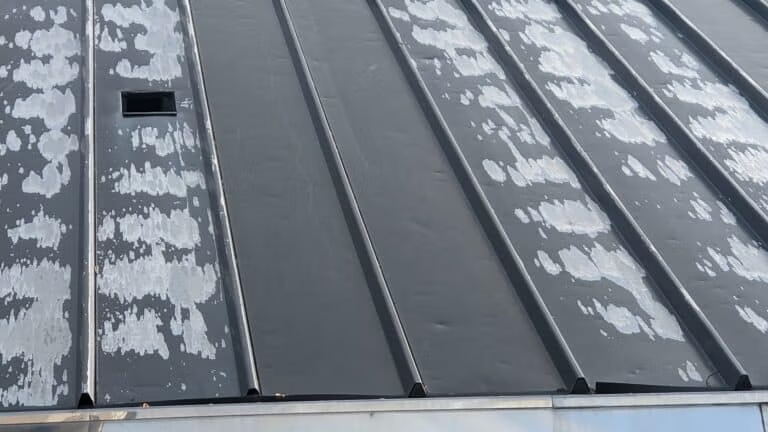Choosing the right roofing material involves balancing factors such as cost, durability, aesthetics, and suitability for your local climate. Asphalt shingles are budget-friendly and easy to install, whereas metal roofing offers superior longevity and energy efficiency.
For a distinctive look, clay tiles provide a Mediterranean vibe, albeit needing strong structural support. Consider wooden shakes if you love a rustic feel, but be prepared for maintenance.
Slate is an elegant and durable option, though it’s heavier and more expensive. Reflect on your specific needs, experiences, and weather conditions to make an informed choice. Continue to learn how each factor can impact your home and budget.
Factors to Consider When Choosing Roofing Materials
- Assess climate suitability: Choose materials that perform well in your local weather conditions to ensure durability and minimize maintenance costs.
- Consider cost factors: Evaluate initial costs, installation fees, and long-term maintenance expenses to fit your budget and financial plan.
- Evaluate longevity and durability: Select materials based on their lifespan and resilience to avoid frequent replacements and repairs.
- Match aesthetic preferences: Choose colors, textures, and styles that complement your home’s architectural design and exterior appearance.
- Prioritize energy efficiency: Opt for materials that improve insulation and energy efficiency to reduce heating and cooling expenses.
Types of Roofing Materials

When selecting roofing materials, it is crucial to understand the various types available, each offering distinct advantages and characteristics. Asphalt shingles, for instance, are the most popular choice in North America due to their affordability and ease of installation. I recall when I first helped my parents replace their roof; the contractor recommended asphalt shingles, which not only matched our budget but also provided a reliable and aesthetically pleasing option.
Another common material is metal roofing, known for its durability and energy efficiency. My neighbor recently opted for a metal roof, and although the initial cost was higher, they were thrilled with the long-term savings on energy bills and the modern look it provided.
Clay and concrete tiles offer a distinct Mediterranean aesthetic and are celebrated for their longevity and fire resistance. They remind me of my vacation in Spain, where I admired the beautiful, rustic rooftops that seemed to withstand the test of time.
Benefits and Drawbacks
Evaluating the benefits and drawbacks of each roofing material is essential to making an informed decision that aligns with your specific needs and circumstances. As a homeowner in a coastal area, I personally found the durability of metal roofing appealing due to its excellent resistance to harsh weather conditions. However, the noise during heavy rain was a drawback I hadn’t anticipated.
Asphalt shingles are popular for their affordability and ease of installation. They offer a decent lifespan but may not perform well under extreme weather conditions, a concern if you live in storm-prone areas. Conversely, clay tiles boast impressive longevity and aesthetic appeal, an ideal choice if you favor traditional, elegant designs. Yet, their significant weight requires a robust structural support, which can be a limitation for some homes.
Wooden shakes exude a rustic charm and provide good insulation. However, they demand regular maintenance and aren’t the best option for fire-prone regions. Slate roofing, known for its exceptional durability and timeless beauty, might be appealing but comes with a high upfront installation challenge due to its weight.
Understanding these pros and cons aids in selecting a roofing material that best fits your lifestyle and environmental conditions.
Cost Considerations

Considering the financial implications of each roofing material is crucial to ensuring that your choice aligns with your budget while still meeting your functional and aesthetic needs. When my family and I were choosing a new roof for our home, we quickly realized that costs can vary widely based on material, installation, and long-term maintenance. Here are some key aspects to consider:
- Initial Cost: The upfront expense of materials like asphalt shingles, metal roofing, or clay tiles can differ significantly. For instance, asphalt shingles are typically more affordable than metal or slate options.
- Installation Fees: Some materials are more labor-intensive to install, which can increase overall costs. For example, while asphalt shingles might be less expensive to install, materials like tile or slate require specialized skills.
- Maintenance Costs: Consider the long-term maintenance expenses. Metal roofs might be pricier initially but often require less upkeep compared to wood shingles.
- Energy Efficiency: Roofing materials that offer better insulation can reduce energy bills, providing cost savings over time.
- Local Climate: Choose materials suited to your local climate to avoid frequent repairs, which can be costly.
Lifespan and Durability
In the realm of roofing materials, lifespan and durability are paramount factors that directly influence the long-term value and performance of your roof. When selecting a roofing material, it is essential to consider how long it will last and how well it will withstand various environmental stressors.
Take, for instance, asphalt shingles, which are popular due to their affordability and ease of installation. However, they typically last only 20 to 30 years. In contrast, metal roofing can endure for 40 to 70 years, offering superior resistance to wind and fire. My own home, with its metal roof, has weathered numerous storms without a hitch, providing peace of mind and long-term savings.
Consider the extreme durability of slate roofs, which can last over a century. However, they are heavy and require a robust structural support system, a crucial point to keep in mind. More recently, synthetic roofing materials have emerged, offering a balance of longevity and resilience, often mimicking the appearance of traditional materials.
Your choice should align with your specific needs and environmental conditions. Investing in a durable roof pays off by reducing maintenance costs and extending the time before a replacement is necessary, thereby ensuring your home’s protection for decades.
Aesthetic Choices

Selecting the right roofing material involves not only practical considerations but also the aesthetic appeal, as your roof significantly contributes to your home’s overall visual impact. When my wife and I were renovating our home, we spent countless hours sifting through various options, each with its unique charm and character. Here are some key aesthetic choices to consider:
- Color: The color of your roofing material can either complement or contrast with your home’s exterior. Earthy tones blend seamlessly with natural surroundings, while bold colors make a statement.
- Texture: Different materials offer various textures. Slate, for example, has a rugged, natural look, while metal roofing can provide a sleek, modern finish.
- Style: The architectural style of your home should guide your choice. Traditional homes often look best with classic materials like clay tiles or wood shakes, while contemporary designs may benefit from metal or flat roofing.
- Pattern: Some materials come in distinct patterns that can add visual interest. Asphalt shingles, for example, are available in various designs that mimic other materials.
- Finish: Reflective or matte finishes can drastically change the appearance of your roof. Reflective finishes can be eye-catching and modern, while matte finishes offer a more subdued aesthetic.
Frequently Asked Questions
How Do I Find a Reliable Roofing Contractor?
To find a reliable roofing contractor, start by seeking recommendations from friends or family who have had roofing work done. Check online reviews and ratings on platforms like the Better Business Bureau or Angie’s List.
Verify the contractor’s credentials, including licenses and insurance. Request multiple quotes to compare pricing and services, and ensure you obtain a written contract detailing the scope of work and payment terms.
What Are the Best Maintenance Practices for a New Roof?
To ensure the longevity of a new roof, regular inspections are crucial. Clean gutters to prevent water damage and remove debris to avoid mold and algae growth. Promptly address minor issues such as loose or damaged shingles to prevent further deterioration.
Additionally, trimming overhanging branches can minimize the risk of damage from falling limbs. These proactive maintenance practices will help maintain the structural integrity and appearance of your roof.
How Can I Improve My Roof’s Energy Efficiency?
To improve your roof’s energy efficiency, consider installing reflective roofing materials, which help reduce heat absorption. Adding proper insulation can also minimize energy loss. Incorporating ventilation systems ensures proper airflow, preventing heat buildup.
Finally, exploring the installation of solar panels can significantly enhance energy savings. These measures collectively contribute to a more energy-efficient roof, leading to reduced utility costs and a more comfortable living environment.
Are There Any Eco-Friendly Roofing Options?
Eco-friendly roofing options are the green canopy for your home, sheltering it sustainably. Materials such as recycled metal, reclaimed wood, and solar tiles not only reduce environmental impact but also enhance energy efficiency. Personally, I chose recycled shingles for my roof and have noticed a significant drop in energy bills. These options reflect a commitment to sustainability, making them both a practical and conscientious choice for modern homeowners.
What Permits or Regulations Should I Be Aware Of?
When undertaking a roofing project, it is crucial to familiarize yourself with local building codes and zoning regulations. Permits are often required and vary by region, covering aspects such as material specifications, structural integrity, and environmental impact.
Consulting with your local building authority or a licensed contractor will ensure compliance and avoid potential legal complications. Additionally, adhering to these regulations promotes safety and long-term durability of the roofing system.
Conclusion
In summation, selecting appropriate roofing materials demands a careful balance between various factors such as types, benefits, drawbacks, costs, lifespan, and aesthetic appeal. Like the keystone of an arch, the right choice can determine the strength and beauty of a structure.
Each material carries unique attributes that must be weighed against practical needs and visual preferences, ensuring that the chosen option not only shelters but also enhances the architectural integrity of the edifice.






